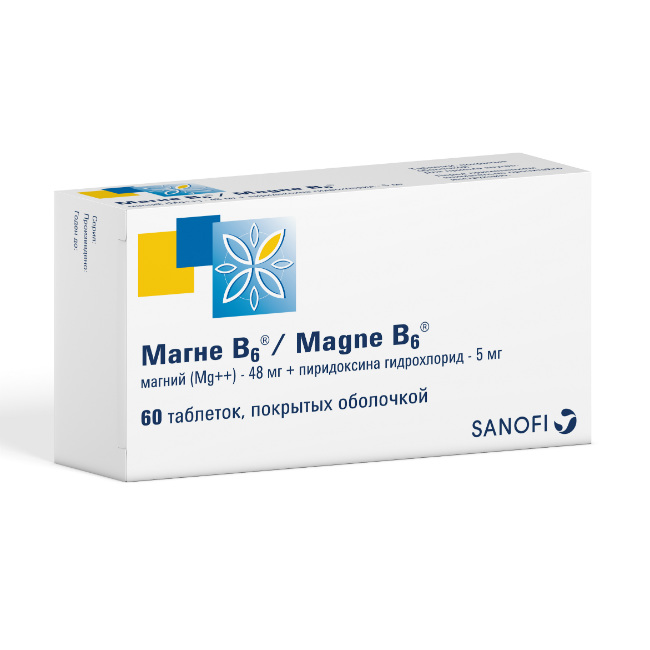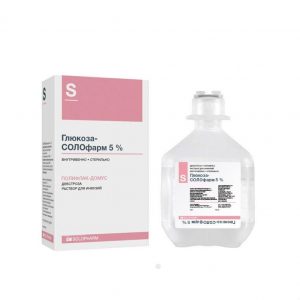Description
Release form
Tablets, coated
Pharmacological action
Magnesium is a vital element that is found in all body tissues and is necessary for the normal functioning of cells, is involved in most metabolic reactions. In particular, it is involved in the regulation of transmission of nerve impulses and in muscle contraction. The body receives magnesium along with food.
A lack of magnesium in the body can be observed with a violation of the diet (diet) or with an increase in the need for magnesium (with increased physical and mental stress, stress, pregnancy, and the use of diuretics). Pyridoxine (vitamin B6) is involved in many metabolic processes, in the regulation of the metabolism of the nervous system.
Vitamin B6 improves the absorption of magnesium from the gastrointestinal tract and its penetration into cells. Serum magnesium content: – from 12 to 17 mg / l (0.5 – 0.7 mmol / l) indicates moderate magnesium deficiency – below 12 mg / l (0.5 mmol / l) indicates severe magnesium deficiency.
Pharmacokinetics
Absorption of magnesium in the gastrointestinal tract is not more than 50% of the oral dose. 99% of the magnesium in the body is inside the cells. About 2/3 of intracellular magnesium is distributed in the bone tissue, and the other 1/3 is in the smooth and striated muscle tissue. Magnesium is excreted mainly in urine. At least 1/3 of the taken dose of magnesium is excreted in the urine.
Indications
Established magnesium deficiency, isolated or associated with other deficient conditions, accompanied by symptoms such as increased irritability, minor sleep disturbances
gastrointestinal cramps or palpitations
increased fatigue, pain and muscle cramps, sensation.
Contraindications
– Hypersensitivity to the components of the drug.
– Severe renal failure (creatinine clearance less than 30 ml / minute).
– Phenylketonuria.
– Children under 6 years of age (for tablets) and up to 1 year (for solution).
– Fructose intolerance, glucose-galactose malabsorption syndrome, sucrose-isomaltase deficiency (only for tablets in the form of sucrose).
– Concurrent administration of levodopa (see section “Interaction with other drugs”).
Precautions For moderate renal failure, as there is a risk of developing hypermagnesemia.
Use during pregnancy and lactation
Clinical experience with the drug in a sufficient number of pregnant women has not revealed any adverse effect on the occurrence of fetal malformations or fetotoxic effects.
Magne B6 ® can be used during pregnancy only if necessary, on the recommendation of a doctor.
Period of breastfeeding Magnesium passes into breast milk.
Use of the drug during lactation and lactation should be avoided.
Special instructions
Information for patients with diabetes: coated tablets contain sucrose as an excipient. In the case of severe magnesium deficiency or malabsorption syndrome, treatment begins with the intravenous administration of magnesium preparations. In case of concomitant calcium deficiency, it is recommended to eliminate magnesium deficiency before taking calcium supplements or dietary supplements containing calcium. With the frequent use of laxatives, alcohol, intense physical and mental stress, the need for magnesium increases, which can lead to the development of a deficiency of magnesium in the body.
Ampoules contain sulfite, which can cause or enhance the manifestations of allergic reactions, including anaphylactic reactions, especially in patients at risk.
When using pyridoxine in high doses (more than 200 mg per day) for a long time (for several months or, in some cases, years), sensory axonal neuropathy may develop, which is accompanied by symptoms such as numbness, impaired proprioceptive sensitivity, tremor of the distal extremities and gradually developing sensory ataxia (impaired coordination of movements).
These disorders are usually reversible and disappear after you stop taking vitamin B6. The drug in the form of tablets is intended only for adults and children over 6 years old. For young children (older than 1 year), the drug is recommended in the form of a solution for oral administration.
Composition of
Core of the tablet:
active ingredients:
magnesium lactate dihydrate * – 470 mg
pyridoxine hydrochloride – 5 mg
auxiliaries:
sucrose – 115.6 mg,
karol heavy, 20.0 mg,
carboxypolymethylene 934 – 10.0 mg,
talc (magnesium hydrosilicate) – 42.7 mg,
magnesium stearate – 6.7 mg.
shell tablets:
acacia gum – 3.615 mg,
sucrose – 214.969 mg,
titanium dioxide – 1.416 mg,
talc (magnesium hydrosilicate) – traces,
carnauba wax (powder) – traces.
* – equivalent to magnesium (Mg ++) 48 mg
Dosage and administration of
Before taking the drug, consult your doctor.
Coated Tablets Adults are advised to take 6-8 tablets per day.
Children over 6 years of age (weighing more than 20 kg) 4-6 tablets per day.
Side effects of
Immune system disorders Very rare (<0.01%): allergic reactions, including skin reactions. Disorders of the gastrointestinal tract. Unknown frequency (according to available data, it is not possible to estimate the frequency of occurrence): diarrhea, abdominal pain, nausea, vomiting, flatulence. Drug Interactions Contraindicated combinations of – With levodopa: levodopa activity is inhibited by pyridoxine (if this drug is not combined with the use of aromatic L-amino acid peripheral decarboxylase inhibitors). Avoid taking any amount of pyridoxine, if levodopa is not taken in combination with peripheral aromatic L-amino acid inhibitors. Not recommended combinations – Concomitant use of drugs containing phosphates or calcium salts may impair intestinal absorption of magnesium. Combinations to be taken into account – When using tetracyclines orally, you must observe an interval of at least three hours between ingestion of tetracycline and Magne B6 ®, since magnesium preparations reduce the absorption of tetracyclines. Overdose of With normal renal function, an overdose of magnesium when ingested usually does not lead to toxic reactions. However, in case of renal failure, magnesium poisoning may develop. Overdose symptoms, the severity of which depends on the concentration of magnesium in the blood: lowering blood pressure nausea, vomiting, depression of the central nervous system, decreased reflexes of changes in the electrocardiogram, respiratory depression, coma, cardiac arrest and respiratory paralysis anuric syndrome. Treatment Rehydration, forced diuresis. In renal failure, hemodialysis or peritoneal dialysis is necessary. Storage conditions Tablets coated: in a dry, dark place at a temperature not exceeding 25 ° C Expiration 2 years. lekarstvennaja form tablets Indications for gastrointestinal spasms, From neurosis, For insomnia




